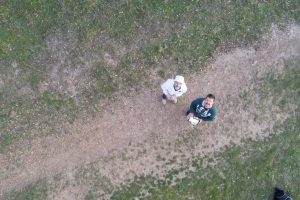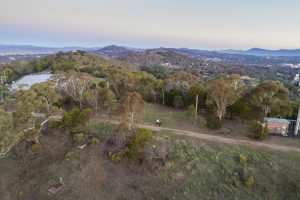
From the look-out at the top of Red Hill one can see Canberra airport. As I walk along, my attention is drawn to a light plane, headlights clearly visible in the growing dusk, high in the sky above the ridge ahead of me.
Suddenly, a sense of alarm and panic: the light plane appears to be stationary, like a gull in a sea breeze, and I know enough about aeronautics to be sure that stationary is not a sustainable condition for a light plane when in the air.
My gaze is fixed. What I can see soon merges with what I can hear. The light plane appears to be making a buzzing noise.
As I progress further up towards the crest of the hill, my senses join in interpreting the phenomenon more accurately. It is not a light plane high in the sky several kilometres away. It is a drone, zipping back and forth – and some time still – just 44 metres above the ground.
I know it’s 44 metres because that is one of the pieces of information I get from my discussion with Andrew, who is operating the drone. I find out that it is a DJI Phantom 4 Pro (DJI is the brand). The Phantom 4 Pro features an automatic obstacle-avoidance system. Andrew demonstrates it. The aerial beast rushes towards the nearby trees but then pulls up in the air and hovers. It charges through the air towards us but then, suddenly shy and diffident, keeps its distance about 2 yards in front of us.
This wondrous machine is about the size of an iPad with a rotor blade on each of the four corners. It has a small amount of superstructure underneath the flat surface, which includes a camera which is broadcasting sharp images back to Andrew’s handpiece.
I am absolutely entranced. People could talk to me or write about drones until they are purple in the face and I would show scarcely any interest. But to see one zipping about so rapidly and with great dexterity above our heads is absolutely intriguing.

The battery operating the rotors gives about 25 minutes’ flying time. The specifications for this model suggest that it has a reach which extends 6 km upwards and 7 km out. But Andrew will not be able to test that capacity at this site given the regulations for the operation of drones, which rest with the Civil Aviation Safety Authority (CASA).
“Australia’s safety laws for drones, or more technically correct, remotely piloted aircraft (RPA), as defined in the Civil Aviation Safety Regulations Part 101, vary whether you are flying commercially or recreationally/for fun.
When flying for money, or any form of economic gain, you need to have an RPA operator’s certificate (ReOC), or if you’re flying an RPA weighing less than two kilograms, simply notify us.
When flying for fun and not commercially, or for any form of economic gain, then the regulations are less restrictive and allow you to fly an RPA without needing to be certified, providing you follow some simple safety rules.
Check out our information sheet on the basic rules for flying RPAs.”
The model I am watching in the sky above me is made in China. It’s less than 2 kgs. Cost: around $2500. Larger ones can cost up to $40,000. Judging from the dexterity with which he appears to be handling the drone I surmise that Andrew has many hours’ flying experience. In fact it’s about three.
Currently there are two sets of rules, one for sub-2kg drones and another for larger ones. Andrew tells me that much in the basic rules and guidelines is common sense.
The rules for commercial sub-2kg operation dictate that they may not be flown within 5.5km of a controlled aerodrome, no closer than 30m to other persons not involved in the drone’s operation, not over populous areas, and not over emergency situations (police operations, fires etc). They may only be flown during the day, and only one drone may be flown at a time by the one operator. ‘Populous areas’ include public parks and Raiders’ games – in case there is a fault and they fall on someone’s head.
Andrew has notified CASA of his intention to operate a sub-2kg drone commercially and is considering the further certification required to obtain a a remote pilot licence (RePL) and an RPA operator’s certificate to enable him to fly larger ones. (These further steps are quite expensive and time-consuming.) The certification he already has means that some of the stricter requirements that apply to non-certified sub-2kg operators do not apply.
One final question. And the answer is no: security clearance is not required.

I couldn’t wait to get home to tell of my direct contact with new technology. For someone who still doesn’t have a cordless phone, my degree of excitement was perhaps surprising.
It’s my personal introduction to one element of the ‘automation’ that is already proving to be such a boon and such a worry to communities and economies everywhere.
Note: thanks very much to ‘Andrew’.
